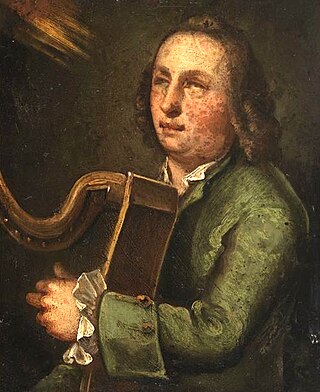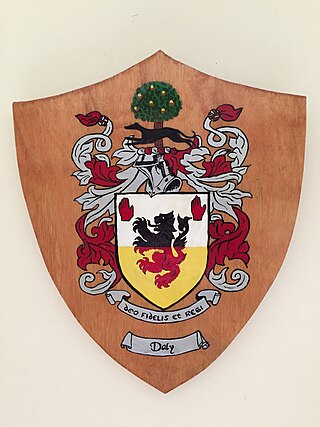History
The air, and the texts fitted to it, have a long and very complex history. Its exact provenance is unknown, but it has been variously asserted by different authors as dating from the 13th century, from the time of Henry VIII, or from the 17th century, though the latter is the most credible. [1] There are at least two main Irish language texts and a number of later English translations, or interpretations of both; there are also English words (such as those by Moore) which are not a translation of either Irish version.
The air
The air itself is sometimes claimed to have been composed by Carolan, though John Glen (1900) said that the "ancient Irish melody" was in fact usually known as "Molly St George" at the beginning of the 18th century. [2] The latter-named tune has been often been associated with the great 17th-century harper Thomas Connellan. Connellan was also cited alongside Carolan as a possible composer of The Coolin, but as Glen noted, many supposed "that the tune is older than either of them". [2]
The version of The Coolin printed by Edward Bunting in The Ancient Music of Ireland (1840) was taken from the playing of Donnchadh Ó Hámsaigh (Dennis Hempson), who himself claimed to have learned it from the playing of Cornelius Lyons early in the previous century. Though Bunting's setting claims to present the tune with variations, it in fact appears to print only Lyons' once-fashionable baroque variations while omitting the main tune. [3] Patrick Weston Joyce, who said that Bunting's version was "wanting in simplicity", printed a version of the tune collected from the playing of a fiddler, Hugh O'Beirne, that he said was very similar to that he recalled being sung in his youth in 1830s County Limerick. [4]
Other versions appeared in several late 18th century collections, as well as in the 1795 opera The Wicklow Mountains, written by John O'Keeffe with music by William Shield.
Claimed 13th or 16th century origins
These suggestions originated with Joseph Cooper Walker, who said in his Historical Memoirs of the Irish Bards (1786) that the air's title in fact referred to what he called the "coulins", or long locks of hair, worn by Irish men and which were prohibited by a statute of Henry VIII, although he noted that no actual words to the air on this subject had survived. [5] Despite the lack of a text, Walker's assertion was repeated by, amongst others, Renehan and W. H. Grattan Flood: Flood however proposed (based on a suggestion by Lynch in a letter to the Dublin Penny Journal) the air must refer to an earlier statute of the 13th century. The story inspired a 19th-century patriotic poem called The Coulin Forbidden, written by W. B. McBurney under the pseudonym "Carroll Malone".

The philologist Eugene O'Curry asserted, however, that the title "The Coolin" was only applied to the air in the 18th century after it was used by a priest, Fr. Oliver O'Hanley, to set a poem he wrote in praise of a famous beauty of County Limerick. [6] In this case, O'Curry commented, the word "Coolin" is used in its sense "fair-haired one", to refer to a girl: he disagrees with Walker, stating "no such word was ever, or ever could have been, applied to the glibbs, or long tufts of back hair, prohibited by old English statute". [6]
The Rev. L. Donnellan, in a survey of the various texts and tunes of The Coolin, published in the 1912 Journal of the County Louth Archaeological Society, was equally dismissive: he states that Walker's "credulous" story of it referring to an English statute was "fabricated by his friend [William] Beauford". [1] He also notes that what he called Walker's "foolish speculation" was encouraged by his insertion of the phrase "glibbs and coulins" into the 16th century statute, which he notes only refers to proscribed "glibbs". [1] Donnellan's conclusion was that the original composition was a 17th-century one attributed to O Duagain (see below).
Text attributed to Ó Duagáin
The oldest and best-known Irish text definitely associated with the tune is a love-poem addressed to a fair-haired girl (cúilfhionn); this is attributed to a poet called Muiris Ó Duagáin or Maurice O'Dugan of Benburb and said to have been written in around 1641. [7] English translations of this text have been written by Sir Samuel Ferguson (beginning "O have you seen the Coolun") and Thomas Furlong, amongst others. The latter was printed by James Hardiman, along with Ó Duagaáin's original text, in his collection Irish Minstrelsy (1831).
A version of Ó Duagáin of Benburb's poem was also printed, with translations, in Douglas Hyde's Love Songs of Connacht (1893), with the first line A's éirigh do shuidhe a bhuachaill a's gléus dam mo ghearrán ("And rise up lad, and get ready for me my nag"). Hyde omits two stanzas already printed by Hardiman, and describes this as a version collected in Connacht. [8]
Donnellan, after dismissing Walker, Grattan Flood and O'Curry's other suggestions, states that the probability "is that O'Dugan of Benburb did compose a poem with this air perhaps substantially the same as the different versions given by Hardiman, Vol. I., p. 251; O'Daly, p. 155; and Dr. Hyde, pp. 70-73 in the Love Songs of Connacht". [1]
Text attributed to O'Hanley
Writing in the early 1800s, O'Curry said that the title "The Coolin" was first applied to the air in the 18th century after it was used by a poet, Father Oliver O'Hanley (fl. 1700-1750), to set an Irish-language poem he had written in praise of Nelly O'Grady, a celebrated beauty of County Limerick. [6] This text, beginning Ceó meala lá seaca, ar choilltibh dubha baraighe ("A honey mist on a day of frost, in a dark oak wood"), and which is addressed to Neilidh ("Nelly") was printed by Hyde, who said it was written in a manuscript originating in County Clare, though the manuscript was partly damaged and he could not read two stanzas. [8]
Other texts
Hyde noted the existence of what he called a Munster version of the poem, given in O'Daly's The poets and poetry of Munster (1850). [8] This shares some material with that attributed to Ó Duagáin, but is only three stanzas long and includes a reference to a member of the Power family. [9]
Another well-known text was written for the air in English by the poet Thomas Moore, usually known by its first line Though the last glimpse of Erin. It is not a translation of any of the earlier Irish versions. Donnellan noted that the version of the air used by Moore was substantially "correct and unaltered", particularly in comparison to Bunting's, when compared with early 19th and late 18th century copies of the tune, though it still showed some evidence of having been adapted by an "instrumentalist". [10]






